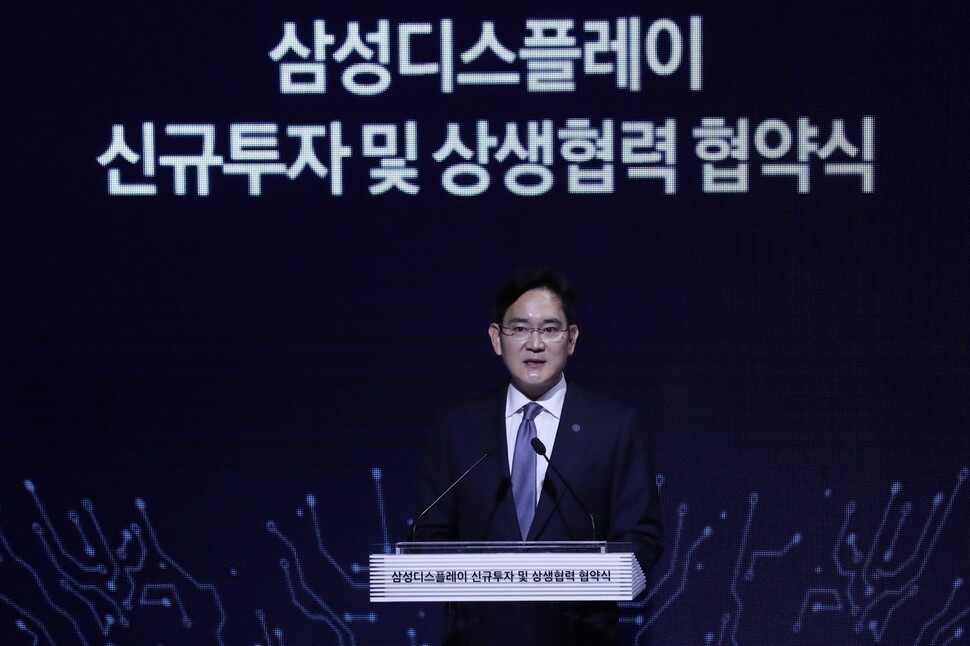hankyoreh
Links to other country sites 다른 나라 사이트 링크
Samsung Display to shrink LCD production and focus on OLED displays

Samsung Display is shrinking its production line for large LCD (liquid-crystal displays) and shifting to QD (quantum-dot) displays, a type of large OLED (organic light-emitting diode) display. This shift is being driven by the crisis the company faces because of a massive influx of cheap Chinese LCD panels into the market. The announcement of this shift came later than expected, which analysts suspect may have been affected by variables including the ongoing trial of Samsung Electronics Vice Chairman Lee Jae-yong.
Samsung Display is planning to invest 13.1 trillion won (US$11.02 billion) through 2025 in setting up what it calls “Q1,” the world’s first assembly line for QD displays. The company plans to move beyond its 8th generation LCD line and produce 8.5-generation super-large QD displays (65 inches and above) by 2021. Samsung will devote 10 trillion won (US$8.41 billion) will be spent on facility investment and 3.1 trillion won (US$2.61 billion) on developing next-generation technology. While Samsung Display doesn’t deny that it’s leaping into the large OLED market, which had been dominated by LG Display, it stresses that its QD technology is distinct from the white OLED (W-OLED) technology adopted by LG.
People have been predicting that Samsung Display would be making such a change for a while now. Chinese display companies, including BOE, have been making rapid inroads on Samsung and LG’s market share, thanks to their more competitive prices. Figures released by HIS Markit show that South Korea was number one in the large LCD market in 2016, with a 35.6% share (based on shipments), while China stood at 26.4%. But South Korean companies were overtaken by their Chinese rivals in 2017, and the gap between them grew wider in 2018, with South Korea at 27% and China at 34.5%. The price for LCD panels has taken a nosedive, from US$156 (for a 55-inch screen) in August 2018 to US$106 this past August.
Market analysts had been raising the possibility of a line shift since last year, and the announcement was expected to take place this summer. But the timing was reportedly delayed along with the Supreme Court’s ruling in Lee’s trial. Many analysts believe that what’s known as “owner risk” had an impact on the timing of the investment decision.
The timing of the announcement itself is also suggestive, coming just two weeks before the high court begins to review charges against Lee on Oct. 25. Lee has been making his presence felt with his first visit to an overseas Samsung C&T plant on Sept. 15, amid the growing likelihood that he’ll be put back behind bars following the Supreme Court’s ruling that illegal attempts to help him inherit control of the Samsung Group could be construed as bribery. Another reason for the delay of the decision to switch to large OLED was Samsung Electronics’ successful fight to hold its number-one position in the global market with its LCD-based QLED televisions, in contrast with the crisis brewing at Samsung Display. Samsung affiliates were apparently working at cross-purposes, which some analysts have attributed to the instability of Lee’s leadership.
The new investment at Samsung Display, an affiliate of Samsung Electronics, suggests that change is also in the cards at the latter’s television division, the global market leader. Samsung Electronics has competed with LG Electronics’ OLED-TV with its own QLED-TV, which attaches quantum-dot film to LCDs. While the QLED-TV has previously focused on the high end, Samsung’s likely strategy going forward is to expand that portfolio into the mid-priced range while using its new QD displays to draw a bead on the premium market.
By Song Gyung-hwa, staff reporter
Please direct comments or questions to [english@hani.co.kr]

Editorial・opinion
![[Column] Season 2 of special prosecutor probe may be coming to Korea soon [Column] Season 2 of special prosecutor probe may be coming to Korea soon](https://flexible.img.hani.co.kr/flexible/normal/500/300/imgdb/original/2024/0426/3317141030699447.jpg) [Column] Season 2 of special prosecutor probe may be coming to Korea soon
[Column] Season 2 of special prosecutor probe may be coming to Korea soon![[Column] Park Geun-hye déjà vu in Yoon Suk-yeol [Column] Park Geun-hye déjà vu in Yoon Suk-yeol](https://flexible.img.hani.co.kr/flexible/normal/500/300/imgdb/original/2024/0424/651713945113788.jpg) [Column] Park Geun-hye déjà vu in Yoon Suk-yeol
[Column] Park Geun-hye déjà vu in Yoon Suk-yeol- [Editorial] New weight of N. Korea’s nuclear threats makes dialogue all the more urgent
- [Guest essay] The real reason Korea’s new right wants to dub Rhee a founding father
- [Column] ‘Choson’: Is it time we start referring to N. Korea in its own terms?
- [Editorial] Japan’s rewriting of history with Korea has gone too far
- [Column] The president’s questionable capacity for dialogue
- [Column] Are chaebol firms just pizza pies for families to divvy up as they please?
- [Column] Has Korea, too, crossed the Rubicon on China?
- [Correspondent’s column] In Japan’s alliance with US, echoes of its past alliances with UK
Most viewed articles
- 1The dream K-drama boyfriend stealing hearts and screens in Japan
- 2‘We must say no’: Seoul defense chief on Korean, USFK involvement in hypothetical Taiwan crisis
- 3AI is catching up with humans at a ‘shocking’ rate
- 4S. Korea “monitoring developments” after report of secret Chinese police station in Seoul
- 5[Column] Can we finally put to bed the theory that Sewol ferry crashed into a submarine?
- 6[Editorial] Yoon cries wolf of political attacks amid criticism over Tokyo summit
- 7[Photo] “Comfort woman” survivor calls on president to fulfill promises
- 8Doubts remain over whether Yoon will get his money out of trip to Japan
- 9Up-and-coming Indonesian group StarBe spills what it learned during K-pop training in Seoul
- 10[Editorial] Was justice served in acquittal of Samsung’s Lee Jae-yong?